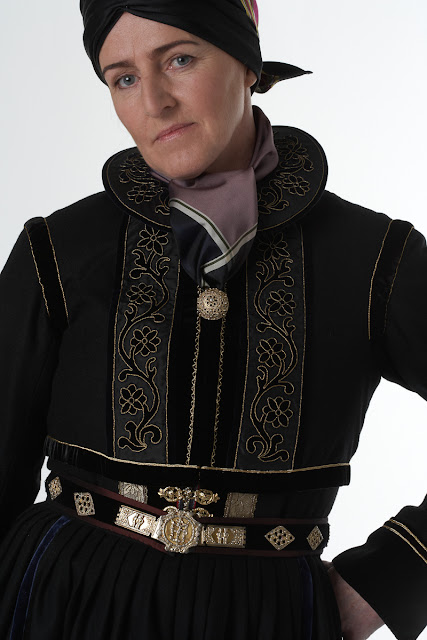Hello all,
Today I would like to start a series on the folk or national costumes of Iceland, in the local language Ísland. Iceland was first settled by the Norse in 874, the first known settler being Ingólfur Arnarson, although it is known that Gaelic monks had lived there earlier. The settlers were mostly from what is now Norway, with some admixture of Irish and Scots.
The Icelandic language is little changed since that time, being the closest of all Scandinavian languages to that of the Vikings. Iceland is a large island northwest of the British Isles. It is a favorite site for geneological research, because there are not a large number of people, and the ancestry of every person has been meticulously documented since their arrival.
There are no traditional regions, the population being mostly on the coasts. The capitol is Reykjavík, and this is their flag.
For more information see this article.
Íslenski Þjóðbúningurinn is the name for the national or folk costumes of Iceland, you will notice that buningur is from the same root as the Norwegian bunad. To help you pronounce this, the first letter is called 'thorn', and is pronounced like th in thin, the fourth letter is pronounced like th in this. Old English had these letters and then gave them up, a bad idea in my opinion, since English still has these sounds.
There are five types of buningur for women, which are not regional, but all of which belong to the entire nation. Rather they come from different periods and had differing uses.
1. Faldbúningur
2. Upphlutur
3. Peysuföt
4. Skautbúningur
5. Kyrtill
For men there are only two types, an older form and a more modern, formal form.
Faldbúningur is the oldest form, and had gone out of use by around 1850, but has been to some extent revived today. It was also the starting point for most of the other forms. It is characterized by a large white headpiece that curves forward. This was called the krókfaldur.
The form shown above was typical in the 18th cent. In the 19th century the headdress had become flat. This variant was called the spaðafaldur.
Sometimes the hem of each was covered with split-stitch embroidery.
A bodice was worn, and a jacket over that, each of which was often ornamented with ribbon or embroidery. Gold embroidery was often used. The bodice was laced with silver chain.
In some periods the jacket was shorter than the bodice, but at other times they were about the same length.
If the skirt and apron were embroidered, a matching 'loose pocket' was often worn with them.
Rich jewelry was worn, including intricate metal belts. A silk kerchief was often tied around the neck.
Soft slippers or silver buckled shoes were also worn by those who could get them.
I will close with a few more examples of this costume.
I will cover the other variants in future postings.
Thank you for reading, I hope you have found this interesting.
Feel
free to contact me with requests for research. I hope to eventually
cover all of Europe and the Former Russian Empire/Soviet Union. I also
gratefully accept tips on source materials which i may not have. I also
accept commissions to research/design, sew, and/or embroider costumes
or other items for groups or individuals. I also choreograph and teach
folk dance.
Roman K.
email
A good article on the various types of buningur.
http://en.wikipedia.org/wiki/Icelandic_national_costume
Here is the Heimilisiðnaðarsafnið textile museum website
http://textile.is/
The Iceland national costume website. I have relied heavily on this site for information.
http://www.buningurinn.is/?i=2
Other sources:
Hildur Hermóðsdóttir, 'Icelandic National Costumes' Reykjavik, 2012
Elsa Gudjónsson, 'Traditional Icelandic Embroidery', Reykjavik, 1982
Charles Holme, 'Peasant art in Sweden, Lappland and Iceland', London, 1910




























wow this is extremely informative! did icelanders wear corsets or stays, and if so, how similar were they to their european counterparts?
ReplyDeleteI do not know for sure, but I very much doubt it Corsets were never part of traditional country attire, but were a facet of pop culture, City Fashion.
DeleteWomen in Europe who adhered to traditional dress did not wear them either. Corsets were only worn by city women who wanted to keep up with the latest FASHION.
If I may chime in. I am a folklorist/ethnologist from Iceland focusing on the national costumes.
DeleteIt's right Roman that we did not wear corsets back then as people know today, but the upphlutur served that purpose in the Faldbúningur. It is not as tight as a corset is but it worked as a kind of a bra/corset back then. In other words, it was their underwear which later became a seperate and indepentent costume as Roman pointed out in their other blog about that costume.
Great job on these blog posts BTW, it's always fun to see other people work to inform others on national costumes.